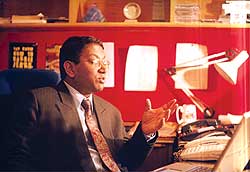Sanjeev Roy is Director for the region of French-based Euro RSCG, the fifth-ranking advertising agency in the world. He was in Kathmandu this week to look at the Nepali market and is excited by the prospects.
 Nepali Times: How come such a big company is interested in a relatively small market like Nepal?
Nepali Times: How come such a big company is interested in a relatively small market like Nepal?
Sanjeev Roy: We have some Indian and global clients who need specific attention in Nepal, some have asked for it, some have not. But we see it as an opportunity, it is a market which doesn't require very high expenditure for you to get any reasonable rate of returns. One thing that I am sensing is that Nepal and indeed all of South Asia is predominantly young, and these young people are not going to be caught up with borders. They are much more international and because there is so much happening, it is going to create a lot of desire, whether the economy grows or not. There is going to be very high levels of competition within media in Nepal, and that means a much bigger role for quality advertising. Irrespective of what the market looks like now, it is going to be rapidly professional and before we realise, it is going to change. That is why we are here with our Nepali partners, Outreach Nepal.
How about your India operations?
Euro RSCG started in India in 1996, and I was one of the start-up members. The key thing was that this was going to be a young, modern entity. All my life I had worked with these large established networks, and something that bothered me is this 'one shoe fits all' was not the way the world was going anyway. Euro RSCG promised to be very different. For example, from the start we went completely digital, in 1996 that was unheard of in India. We started with globally aligned clients like Intel, and we picked local clients along the way and today we are among the top 10 in India.
Isn't the market in India already crowded?
But it's growing all the time. That is the beauty of it, some sector may stagnate, but there are new sectors that get added on every year. So if it's not the cars that fuels growth, then it's the durables or the financials. And the advertising market is growing at anything between 8-12 percent. This sometimes defies logic, but it is growing rapidly.
How much has television impacted on this growth?
It has changed the picture dramatically. And it has also changed things around, so that more budgets have moved towards satellite, especially for brand advertising. Newspapers are still big for corporate or information advertising, but satellite television has really hit the magazine market. But it has also created an opportunity for a whole lot of marketers to expand, like the sari manufacturers. Suddenly they became brands because of television. This means media planning, buying and scheduling functions, which used to be backroom till about five years ago, is up-front.
How has the readership survey and ratings industries reacted? Is there more accuracy?
How do you get anything accurate in a country like India? It's so huge. Something like the National Readership Survey had a sample size of 100,000 and was one of the largest surveys in the world, but it is difficult to say what the right sample size is to guarantee accuracy.
Isn't there a contradiction that the satellite channels have regional footprints, but the content and indeed the advertising is aimed primarily at the Indian market?
There are some channels where regional advertising happens a lot, like CNBC. But any seasoned advertiser who has been to India recognises that there are better bangs for the buck if you plan for India, so a lot of people go through this learning process by going through Singapore or Hong Kong. For most of them, India is the dominant market, and any regional advantage is a happy spillover because the numbers in India are a lot larger. Also, the people in the region who are accessing the Indian channels are predominantly Indian.


